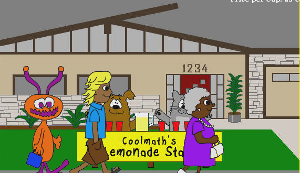Lemonade And Learning
 The game Lemonade Stand demonstrates the application of several learning theories in its design. The game uses both text and images to provide prompts and information for the player, which exemplifies Paivio’s dual-coding theory. According to Paivio, there are two “modes” of representing information in long term memory – verbal, consisting of language expression, and imaginal, consisting of visual and spatial information (Schunk, 1999). LS utilizes both of these modes in its gameplay.
The game Lemonade Stand demonstrates the application of several learning theories in its design. The game uses both text and images to provide prompts and information for the player, which exemplifies Paivio’s dual-coding theory. According to Paivio, there are two “modes” of representing information in long term memory – verbal, consisting of language expression, and imaginal, consisting of visual and spatial information (Schunk, 1999). LS utilizes both of these modes in its gameplay.
Another learning theory evident in Lemonade Stand is situated cognition. This theory explains that thinking and learning are affected by the context in which they occur. They involve the relationship between a learner and a situation (Schunk, 1999). Lemonade Stand places the relevant knowledge in the context of running a stand – in order to decide how your investments will grow (or shrink) you place those choices in the context of investing a lemonade stand business.
Information processing is a theory that states that learning occurs in stages as information is processed in different ways by the brain. Each time information is retrieved from memory, information is processed again by the brain and in a sense re-learned. Information processing theorists describe different cognitive activities necessary for learning, including rehearsing and remembering (Baddeley, 1999). Lemonade Stand provides for information to be processed in various ways during gameplay by providing players with multiple “days” to run their stand and try out different theories of running the business. Players can practice strategies they think will work, and each day have to remember the outcome of previous days.
Lemonade Stand can also be described using the theory of cognitive dissonance. This theory states that learning occurs when a person encounters a conflict between knowledge they had and new knowledge, or even between two different pieces of knowledge that they previously did not realize conflicted (Hollingsworth, 1989). The learner must find a way to resolve the apparent conflict and integrate new knowledge that either incorporates both pieces of knowledge or rejects one piece and accepts the other. When players first play Lemonade Stand they have certain ideas about how to run this kind of business. Some of their ideas will be supported, and others will conflict with the feedback they get from the game. Players have to reconcile what they know with what happens in the game in order to be successful.
Anchored instruction involves placing learners in the context of a story. They have to play a role while learning about the situation and developing solutions. Using anchored instruction enhances transferability of new knowledge (Squire, 2002). Games in general are a great example of anchored instruction, and specifically realistic simulations. Lemonade Stand provides an environment in which to practice what it would be like in real life to run a lemonade stand business and the knowledge gained through gameplay is directly transferable to a real-life stand.
References
Baddeley, A. (1999). Essentials of Human Memory (1st ed.). Taylor & Francis.
Hollingsworth, S. (1989). Prior Beliefs and Cognitive Change in Learning to Teach. American educational research journal, 26(2), p. 160.
Schunk, D. H. (1999). Learning Theories: An Educational Perspective (3rd ed.). Prentice Hall.
Squire, K. (2002). Cultural Framing of Computer/Video Games. The International Journal of Computer
Game Research, 2(1).
Elisa teaches online professional development courses for teachers at teachertechtraining.com.
Register now for Teaching With Games - starts Monday January 4, 2016. Save $50 - Register by December 7, 2015!




 A passion for creating educational multimedia, especially digital games. Fascinated by the challenge of integrating gameplay mechanics with educational content to create a true intrinsic learning experience. Interested in technology and special ed, digital storytelling, and science education. Closet science geek (shhh!!!)
A passion for creating educational multimedia, especially digital games. Fascinated by the challenge of integrating gameplay mechanics with educational content to create a true intrinsic learning experience. Interested in technology and special ed, digital storytelling, and science education. Closet science geek (shhh!!!)